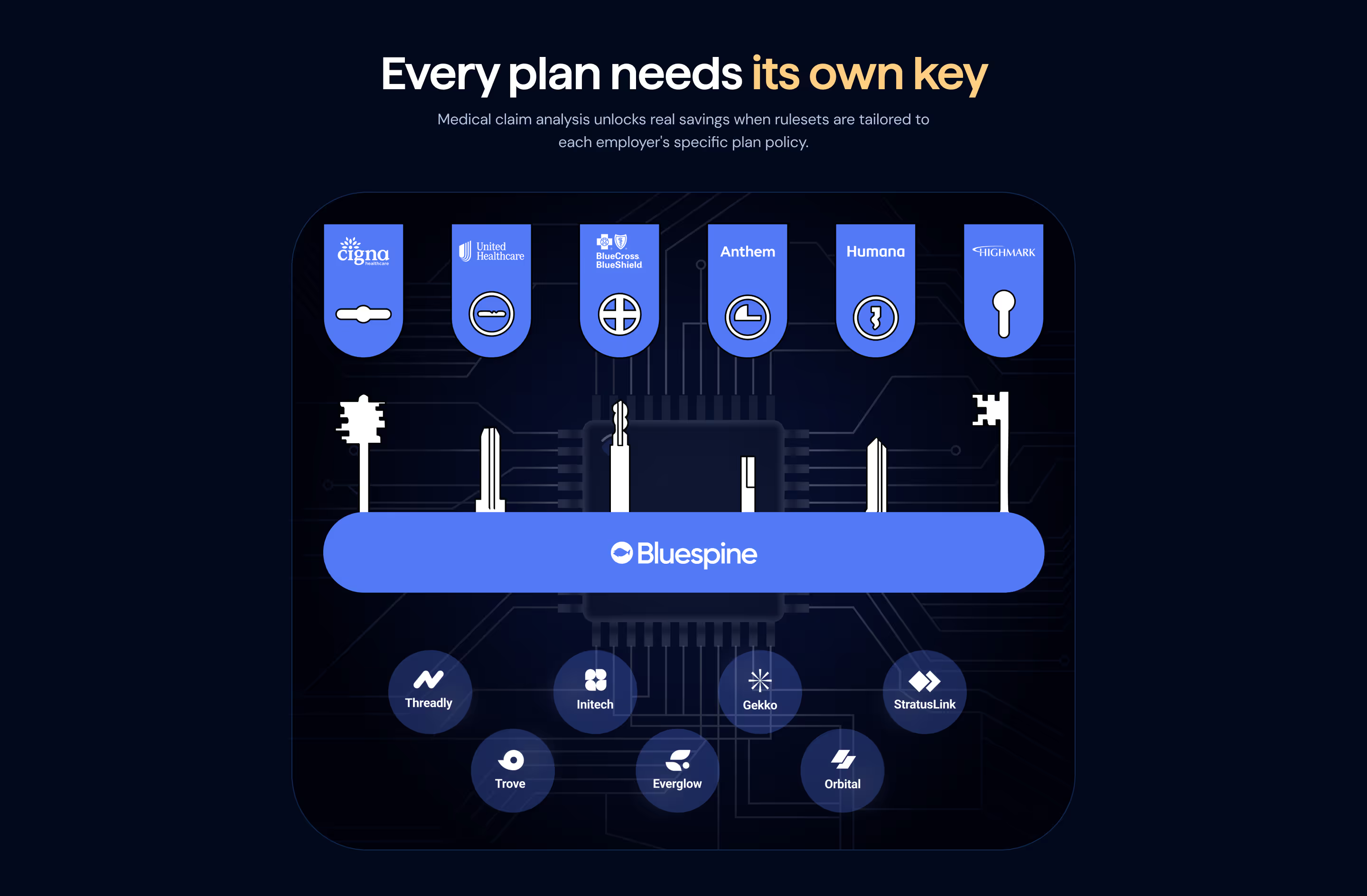
Your second-largest expense (after payroll) is costing way more than it should. Up to 80% of healthcare claims contain errors, and most are slipping past your current payment integrity tools. For self-insured employers, that’s a lot of wasteful spending.
The issue isn’t incompetence; it’s a fundamental design flaw. Most traditional payment integrity systems use generic rule sets that ignore the unique terms in your employee health plans. Since most billing errors stem from deviations from your negotiated plan terms, generic tools miss them entirely. So even if you’re conducting random audits of your claims, you’re not truly protected.
The good news is that new generation AI-powered claims review tools, like Bluespine, change the game. By analyzing your Summary Plan Documents (SPDs), contracts, and negotiated rates, Bluespine builds a custom rule set tailored to your plan, boosting accuracy, recovery, and compliance.
In this article, we’ll show you how Bluespine works, how it outperforms traditional tools, and why outdated systems could be costing you, both in dollars and fiduciary risk.

Even if two companies use the same carrier, their contracts, rates, and coverage differ as each organization negotiates terms based on the demographics and needs of its workforce. As illustrated in the image above depicting each employer’s plan as being unique as a lock.
To audit your claims accurately, you need a key that fits your lock. AI can scan and analyze thousands of claims at once, but it only catches what it’s told to look for. That’s why the rules on which the tool is trained matter.
Traditional payment integrity tools use generic rules: standard billing codes, average prices, geographic benchmarks, and industry norms. They treat every plan from the same carrier as identical, ignoring what you actually negotiated. It’s like trying to open every lock with the same master key; it just doesn’t work.
Bluespine, however, takes a different approach. It builds a custom key for your plan by analyzing your Summary Plan Documents (SPDs), contracts, and negotiated rates.
Most employers assume their claims are being properly reviewed. But if your administrator relies on generic tools, they won’t catch errors tied to your specific pricing. For example, if you negotiated a $500 rate for a drug and get billed $800 (the market average), generic tools won’t flag it, because they don’t “know” your terms.
Now multiply that $300 error by thousands of prescriptions filled annually, and you’re looking at serious financial leakage. And with traditional audits reviewing less than 0.1% of claims, usually just the highest-value ones, countless smaller errors go unchecked, exposing you to financial loss as well as fiduciary risk.
How Bluespine's Customized Approach Works
The breakthrough comes when AI is applied, not to generic benchmarks, but to the actual documents that define your healthcare plan.
That’s exactly what Bluespine does.
It starts with your Summary Plan Documents (SPDs), which spell out what’s covered, what’s excluded, and under what conditions. Then it analyzes your Machine Readable Files (MRFs) that contain your actual, negotiated rates, not market estimates. On top of this, Bluespine analyzes the billing guidelines issued by your carrier for your specific plan.
With this plan-specific information, Bluespine builds a custom ruleset tailored to your coverage terms. The system also updates automatically as new regulations roll out, so your audit engine stays accurate and current with no manual intervention required.
In other words, you finally have the right key to unlock your unique plan.
Fiduciary Risk: When Generic Tools Become a Compliance Liability
Under ERISA, self-insured employers have a legal obligation to manage their healthcare plan’s assets prudently. That includes ensuring costs are reasonable, acting in the best interests of plan members, and maintaining oversight over how funds are spent.
In recent years, the number of ERISA lawsuits has grown significantly, signaling increased scrutiny of employer-sponsored health plans. These cases often center on failure by self-insured employers to adequately monitor their healthcare spending. From inflated pharmacy costs to unverified claim payments, employers across industries are finding themselves in court, not because they intended wrongdoing, but because they lacked the tools to catch it.
Cases like these send the clear message that failing to closely monitor your healthcare spending is a legal risk. With rising healthcare costs, opaque vendor practices, and pressure from regulators, even well-intentioned employers are at risk if they rely on generic audit tools that can’t interpret their specific plan terms.
Bluespine mitigates this risk by providing clear, contract-based oversight. Every error it flags includes a direct reference to the plan term or billing rule that was violated, creating a transparent, audit-ready trail that supports both recovery and compliance.
.avif)
Don't Settle for Guesswork: Demand Your Key
Your healthcare plan is unique. Your claims auditing should be too. Instead of relying on one-size-fits-all rules, Bluespine generates custom rule sets that unlock real savings based on your actual plan terms.
Implementation requires minimal effort from your team. Simply share your plan documents and introduce us to your plan administrator. We handle the rest, reviewing 100% of your claims rather than just the high-cost ones.
In an era of rising healthcare costs and increasing fiduciary scrutiny, don’t risk settling for generic solutions. Your second-largest expense deserves custom protection!
Book a Bluespine demo and see what custom claims auditing can do for your plan.
Start Saving Money Now


